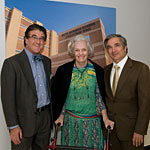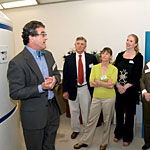
SAN ANTONIO (April 7, 2008) — Scans that show how the body is breaking down sugars … images of blood flow and hormone activity in the brain … real-time studies of compounds that supply energy to the heart, brain and other vital organs. These are just a few of the clinical and research projects made possible by the new Ruth McLean Bowman Bowers Cyclotron Wing, part of the Research Imaging Center at The University of Texas Health Science Center at San Antonio.
The wing is named for San Antonio philanthropist Ruth McLean Bowman Bowers, who has given more than $2 million since 1994 to the research and educational missions of the UT Health Science Center. Her largest gift, $1.6 million, provided integral support for the Research Imaging Center’s recent acquisition and installation of its second cyclotron
Cyclotrons produce radiotracers used in diagnosing diseases and for research
Cyclotrons are powerful particle accelerators that hurtle atoms around lead-encased ovals at dizzying speeds approaching the speed of light. The resulting atomic stir-up generates substances called radiotracers that are used in positron-emission tomography (PET) systems. PET scans, which provide real-time data on body processes such as blood flow, are used in the clinical diagnosis of many diseases and to conduct research of disease processes.
“Your gift has propelled imaging research at the Health Science Center to a new level of prominence,” Francisco G. Cigarroa, M.D., president of the UT Health Science Center, said to Mrs. Bowers and her family during a ceremony to announce the Bowers Cyclotron Wing.
Second cyclotron places Health Science Center in elite group
Thanks to Ruth McLean Bowers, the Health Science Center is the first university in Texas and only the fifth in the U.S. to have two cyclotrons, Dr. Cigarroa said.

Madame Curie was the first to generate artificial radioactivity, the positron emitter N-13, for which she received the Nobel Prize in Chemistry in 1935. Today, radiotracers are used around the world to accelerate the care of patients, including those with cancer, and enable many research discoveries. “For years the Research Imaging Center has manufactured radiotracers for use in cancer diagnosis, including at The Cancer Therapy & Research Center at the UT Health Science Center,” said Peter T. Fox, M.D., director of the Research Imaging Center and professor in the departments of radiology, psychiatry, neurology and physiology at the Health Science Center.
$600,000 income for the Health Science Center
The Research Imaging Center makes radiotracers for area clinical facilities and contracts with Cardinal Health to distribute this valuable diagnostic material to these institutions. “The funds raised, about $600,000 annually, support research at our center and benefit the community because these radiotracers would not be available otherwise,” Dr. Fox said.
The Research Imaging Center’s first cyclotron, acquired with the support of the U.S. Department of Defense and the South Texas Veterans Health Care System in the 1990s, was at its capacity and could not produce enough radiotracer to meet clinical and research demand. These tracers have a very short half-life and must be produced continually to make enough.
The new cyclotron more than triples the center’s tracer output and enables the faculty to generate new tracers that cannot be made on the older model.
As the cyclotron runs, material is pumped to “hot cells” made of lead. Using arms with gloves to manipulate samples, workers fill vials of radiotracers, which are certified to the standards of the U.S. Food and Drug Administration and the Texas Department of State Health Services. “We are licensed like any other drug-manufacturing facility,” Dr. Fox said.
The Bowers Cyclotron Wing is in the Robert F. McDermott Clinical Science Building on the Health Science Center’s Greehey Academic and Research Campus.
The University of Texas Health Science Center at San Antonio is the leading research institution in South Texas and one of the major health sciences universities in the world. With an operating budget of $576 million and 5,000 faculty and staff, the UT Health Science Center is the chief catalyst for the $15.3 billion biosciences and health care sector in San Antonio’s economy. The UT Health Science Center has had an estimated $35 billion impact on the region since inception and has expanded to seven campuses in San Antonio, Laredo, Harlingen and Edinburg. More than 23,000 graduates (physicians, dentists, nurses, scientists and allied health professionals) serve in their fields, including many in Texas. Health Science Center faculty are international leaders in cancer, cardiovascular disease, diabetes, aging, stroke prevention, kidney disease, orthopedics, research imaging, transplant surgery, psychiatry and clinical neurosciences, pain management, genetics, nursing, allied health, dentistry and many other fields. For more information, visit www.uthscsa.edu.

